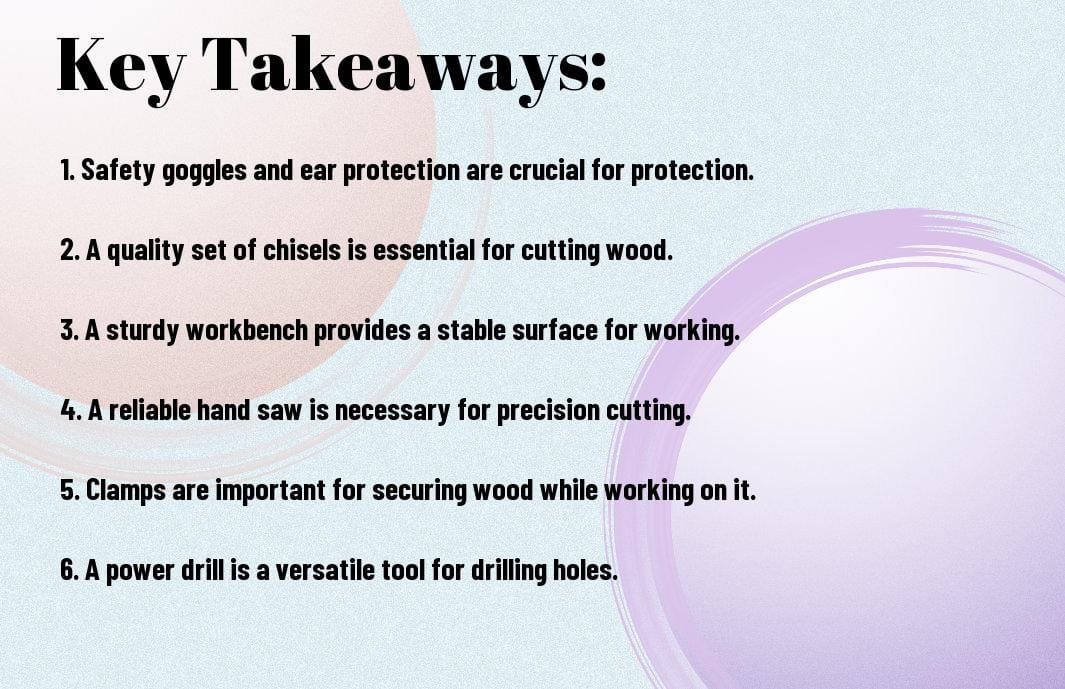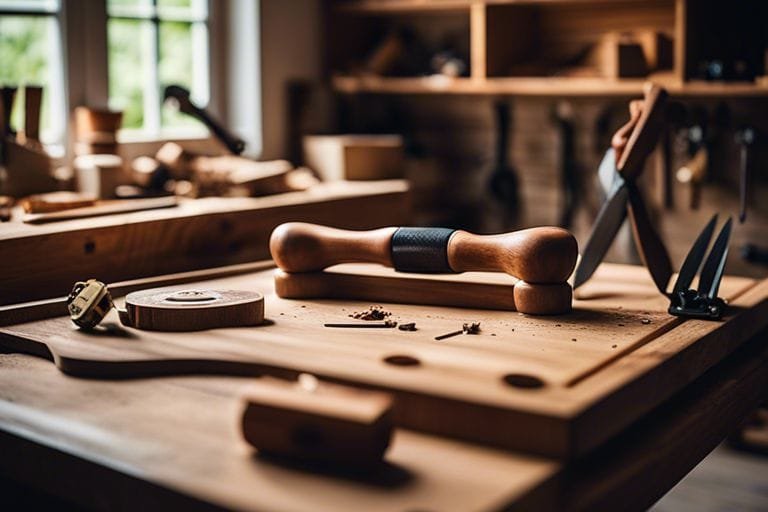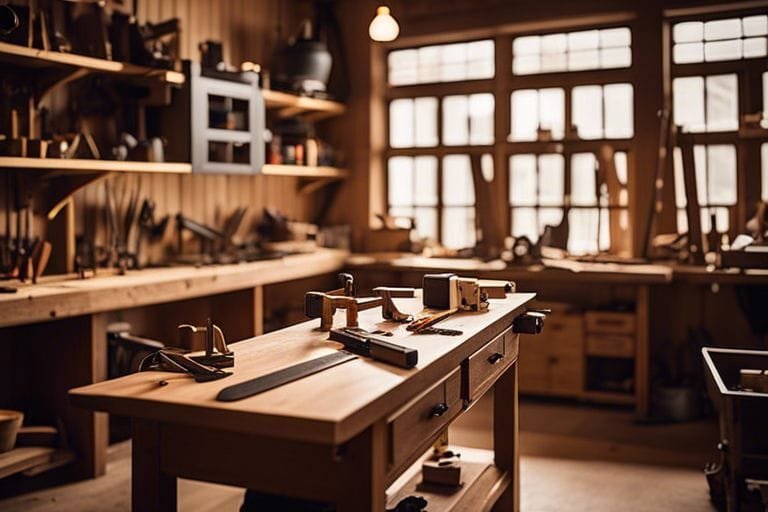Embarking on your journey as a woodworker can be an exciting and fulfilling venture. However, before you dive into your first project, it is imperative that you equip yourself with the essential tools necessary to ensure that your endeavors are successful and safe. As a novice in this craft, it is crucial to understand the significance of using the right tools for the job, and how they can greatly impact the outcome of your woodworking projects.
One of the most important tools for any beginner woodworker is a reliable and sharp set of chisels. These versatile tools are essential for shaping and carving wood, and having a quality set will greatly improve your precision and efficiency. Additionally, a sturdy workbench is crucial for providing a stable and secure surface for your projects. This will not only ensure your safety while working with power tools, but also provide you with a dedicated space to carry out your woodworking tasks. Lastly, investing in a high-quality saw is essential for cutting and shaping wood to the desired dimensions, making it an indispensable tool for any woodworking project.
Key Takeaways:
- Safety gear is paramount: Before even touching wood, beginner woodworkers should invest in safety gear like goggles, ear protection, and gloves to prevent accidents and injury.
- Measuring and marking tools are essential: Accurate measurements are crucial in woodworking, so beginners should have tools like a tape measure, combination square, and marking knife in their arsenal.
- Cutting tools are a must: A basic set of cutting tools like a handsaw, chisels, and a Japanese pull saw are necessary for making precise cuts and shaping wood.
- Joinery and assembly tools are essential: To piece together wood projects, beginners should have tools like a hammer, nails, screws, and clamps to assemble and strengthen their creations.
- Sanding and finishing tools complete the package: To give wood a smooth finish, beginners should have sandpaper, a sanding block, and a basic finish like clear varnish or polyurethane to complete their projects.

Understanding Woodworking Tools
Obviously, as a beginner woodworker, it is essential to understand the various woodworking tools that are necessary for your projects. Having a good grasp of the different tools will help you in selecting the right ones for your specific needs and ensure that you use them correctly to achieve the best results.
Categories of Woodworking Tools
Woodworking tools can be categorized into hand tools and power tools. Hand tools include basic tools such as chisels, hand saws, planes, and clamps. These tools are essential for more precise and detailed woodworking tasks and are often favored for their accuracy and control. On the other hand, power tools, such as a table saw, jigsaw, router, and drill, are more efficient for larger, heavy-duty tasks and can help you achieve precise and quick results. Understanding the distinction between these two categories will help you determine which tools are most suitable for your projects.
The Role of Each Category in Projects
Hand tools play a crucial role in refining and finishing details in your woodworking projects. They offer a level of precision and control that is unmatched by power tools. Using hand tools allows you to carefully carve out intricate designs and ensure a smooth and polished finish on your woodwork. On the other hand, power tools are ideal for cutting through large pieces of wood and shaping them quickly and efficiently. These tools can help you save time and energy, making them essential for more extensive woodworking projects.
As you progress in your woodworking journey, you will find that having a combination of both hand tools and power tools in your workshop will give you the versatility and capability to tackle a wide range of projects. Each category of tools has its strengths and weaknesses, and understanding how to leverage them effectively will significantly enhance the quality of your woodworking projects.
Setting Up Your Workspace
Now that you’ve decided to embark on your woodworking journey, it’s important to set up a functional workspace that will support your projects and ensure your safety. Creating the right environment for woodworking is crucial for your success as a beginner woodworker. In this chapter, we will guide you through the essential steps to setting up a workspace that is safe, efficient, and conducive to learning and creating.
Selecting the Right Space for Woodworking
When choosing a space for woodworking, it’s important to consider several factors. First and foremost, you need a space that is well-ventilated to ensure that any dust and fumes created during woodworking are properly dispersed. Additionally, you’ll want a space that has good lighting to help you see your work clearly and avoid accidents. It’s also important to have enough room to move around comfortably and store your tools and materials.
Organizing Your Workspace for Safety and Efficiency
Once you’ve selected the right space for your woodworking endeavors, it’s time to organize it for safety and efficiency. This means creating designated areas for different tasks, such as cutting, sanding, and assembly. You should also invest in storage solutions for your tools and materials to keep your workspace clutter-free and safe. Additionally, it’s important to have a first aid kit easily accessible in case of any accidents, and to keep your workspace clean and organized to prevent tripping hazards and other safety risks.

Measuring and Marking Tools
After acquiring the basic hand tools, the next step is to focus on measuring and marking tools. These are essential for achieving precision and accuracy in your woodworking projects. In this chapter, we will cover the essential measuring and marking tools that every beginner woodworker should have in their arsenal.
Rulers, Squares, and Measuring Tapes: The Basics of Precision
When it comes to woodworking, precision is everything. Accurate measurements are crucial for ensuring your pieces fit together perfectly and your projects turn out as planned. Rulers, squares, and measuring tapes are the basic tools that will help you achieve this precision. A good quality combination square is a versatile tool that allows you to measure and mark 90-degree angles accurately. A sturdy steel ruler is essential for making straight and consistent measurements, while a measuring tape is handy for longer distances. Investing in high-quality, durable measuring tools will make your woodworking projects much more manageable and enjoyable.
Marking Tools: Pencils, Marking Knives, and Gauges
Once you’ve taken accurate measurements, the next step is to mark your wood accurately. This is where marking tools such as pencils, marking knives, and gauges come into play. Using the right marking tool can make a significant difference in the accuracy and quality of your work. A sharp marking knife allows you to make precise cuts and lines on the wood, ensuring clean and accurate joinery. A mechanical pencil with a fine lead is ideal for marking measurements and lines that need to be visible. Additionally, marking gauges are handy for marking consistent lines parallel to an edge or surface. By using the appropriate marking tools, you can improve the accuracy and fit of your joinery, resulting in a high-quality finished piece.

Cutting Tools
Your woodworking projects will require a variety of cutting tools to shape and create precise cuts in wood. Having the right cutting tools in your arsenal is essential for any beginner woodworker. From handsaws to chisels and planes, each cutting tool serves a specific purpose in woodworking and learning how to use them effectively is crucial for your success.
Handsaws: Types and Techniques for Beginners
When it comes to handsaws, there are several types that you should familiarize yourself with as a beginner woodworker. The most common handsaws used in woodworking include rip saws, crosscut saws, and dovetail saws. Each saw has its own unique tooth pattern and is designed for specific cutting tasks. It’s important to understand the differences and techniques associated with each type of handsaw to achieve the best results in your woodworking projects.
- Rip saws: Designed for cutting wood in the direction of the grain.
- Crosscut saws: Ideal for cutting wood across the grain to create smoother edges.
- Dovetail saws: Perfect for making intricate cuts, such as dovetail joints, in woodworking projects.
Mastering the use of handsaws is essential for any beginner woodworker. Proper technique, including body positioning and hand placement, is crucial for achieving accurate cuts. Learning to control your strokes and allowing the saw to do the work will lead to better results. Perceiving the sound and feel of the saw cutting through the wood will help you determine if you’re using the correct technique.
Chisels and Planes: Shaping Wood with Control
Chisels and planes are essential cutting tools for shaping and smoothing wood surfaces in woodworking projects. Chisels are used for carving, cutting, and paring wood, while planes are essential for shaping and smoothing wood surfaces. It’s important to choose high-quality chisels and planes that will hold an edge and withstand the demands of woodworking.
Using chisels and planes requires precision and control. Understanding how to hold and guide these tools to create the desired shapes and surfaces is a skill that takes practice and patience. Be mindful of the sharpness of the tools and always use caution to avoid injury. It’s important to keep your chisels and planes sharp to achieve clean and smooth cuts in your woodworking projects.
Power Tools for Beginners
Not all woodworking projects can be done by hand, especially if you are a beginner. Power tools can significantly speed up your woodworking projects and make them more precise. However, it is important to choose the right power tools and learn how to use them safely to avoid accidents.
Essential Power Tools to Invest In
When you are just starting out as a woodworker, it is essential to invest in a few key power tools that will help you complete a wide range of projects. A power drill is perhaps the most versatile and essential power tool for any woodworker. Whether you are making holes for screws, dowels, or other fasteners, a power drill will save you time and effort. Another important power tool to invest in is a circular saw. This tool will help you make straight and angled cuts on various types of wood, making it ideal for building furniture and other woodworking projects.
Operating Power Tools Safely
When you are using power tools, safety should always be your top priority. Make sure you are familiar with the specific safety guidelines for each power tool you use. Always wear appropriate safety gear, such as safety goggles, ear protection, and a dust mask. Before operating a power tool, thoroughly read the owner’s manual, and familiarize yourself with the tool’s features and functions. Additionally, make sure your work area is well-lit and free of clutter to avoid accidents. Always keep the power cords away from sharp objects or hot surfaces to prevent electrical hazards.
Joinery Tools
Despite being a beginner woodworker, you will eventually need to familiarize yourself with joinery tools to create strong and lasting connections between pieces of wood. This category of tools includes chisels, hand saws, and more, and it is essential for creating precise and snug joins.
Clamps and Vises: Securing Your Work
When it comes to joinery, securing your workpieces is crucial for accuracy and safety. Clamps and vises are your best friends in this regard. Clamps come in various styles and sizes, including bar clamps, pipe clamps, and spring clamps. They are used to hold pieces of wood firmly together while you work on them. Vises are essential for holding pieces of wood securely in place on your workbench, allowing you to concentrate on your joinery without worrying about the workpiece slipping or moving.
Without the proper use of clamps and vises, you risk ruining the accuracy of your joint work and compromising the safety of your woodworking. It’s important to invest in a variety of clamps and vises to suit different projects and workpieces. Additionally, always ensure that your clamps are tightened securely and evenly to avoid any accidents.
FAQ
Q: What are the essential tools for beginner woodworkers?
A: Essential tools for beginner woodworkers include a combination square, a hammer, a hand saw, chisels, a power drill, a tape measure, a bench plane, and clamps. These tools will enable you to accurately measure, cut, shape, and join wood for your projects.
Q: What is a combination square and why is it essential?
A: A combination square is a versatile measuring tool that can be used for marking 90-degree and 45-degree angles, as well as for checking the flatness of surfaces. It is essential for ensuring accurate and precise measurements in woodworking projects.
Q: Why is a bench plane important for beginner woodworkers?
A: A bench plane is used to smooth and flatten wood surfaces, making it an essential tool for achieving a high-quality finish on your woodworking projects. It can also be used to remove saw marks and fine-tune the dimensions of your workpieces.
Q: How can clamps benefit beginner woodworkers?
A: Clamps are essential for holding wood securely in place while you work on it, whether you’re gluing, assembling, or finishing your project. They help ensure that pieces are aligned correctly and firmly held together during the woodworking process.
Q: What safety equipment is essential for beginner woodworkers?
A: Essential safety equipment for beginner woodworkers includes safety goggles, ear protection, and a dust mask. It is important to protect your eyes, ears, and lungs from the hazards of woodworking, including flying debris, loud noise, and fine wood dust. Safety should always be a top priority in the workshop.



